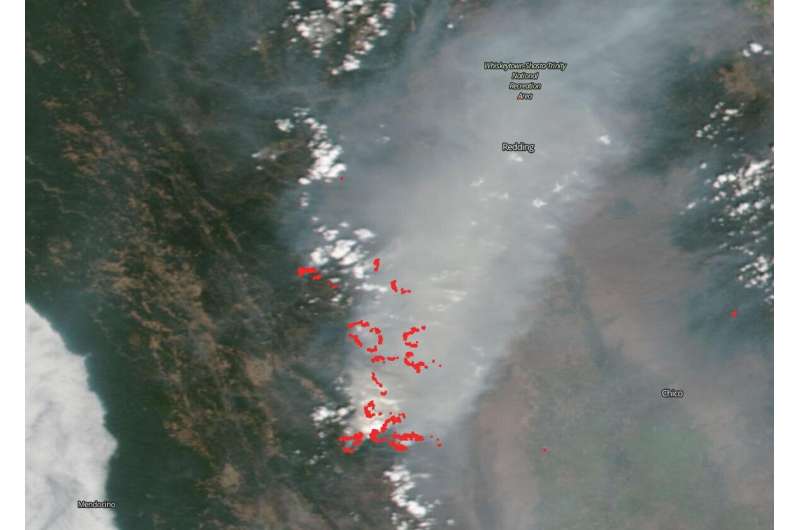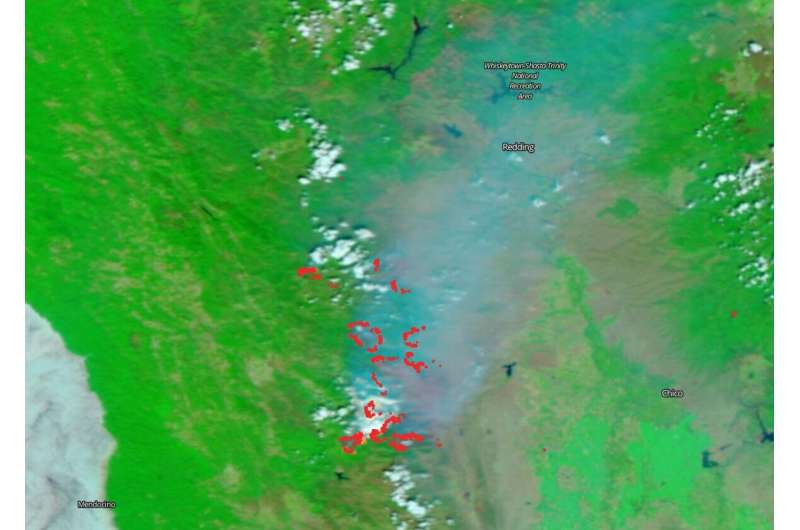NOAA/NASA's Suomi NPP satellite captured another startling image of the August Complex of fires that has grown to over 1,000,000 acres burned (1,006,140 acres total) and because of that grim milestone the complex has been dubbed a "gigafire." The August Complex is only 58% contained. Credit: NASA Worldview, Earth Observing System Data and Information System (EOSDIS).
NOAA/NASA's Suomi NPP satellite captured another startling image of the August Complex of fires that has grown to over 1,000,000 acres burned (1,006,140 acres total) and because of that grim milestone the complex has been dubbed a "gigafire." The August Complex is only 58% contained. Inciweb reports that: "In the northeast zone, active behavior continues. Structures in Hidden Valley, Trinity Pines/Post Mountain, Wildwood and Platina are threatened by fire spread. Short range spotting and fire spread toward Hidden Valley has increased potential for impact to structures."
Another view that can be captured by Suomi NPP satellite is a false-color image. The false-color image is collected by the VIIRS (Visible Infrared Imaging Radiometer Suite) instrument suite using corrected reflectance bands. Burned areas or fire-affected areas are characterized by deposits of charcoal and ash, removal of vegetation and/or the alteration of vegetation structure. When bare soil becomes exposed, the brightness in Band 1 may increase, but that may be offset by the presence of black carbon residue; the near infrared (Band 2) will become darker, and Band 7 becomes more reflective. When assigned to red/brown in the image, Band 7 will show burn scars as deep or bright reddish brown depending on the type of vegetation burned, the amount of residue, or the completeness of the burn. It is hard to see clearly due to the massive amounts of smoke covering the landscape.
Inciweb reports the following weather concerns for this fires: "Hot and dry conditions persist. Smoke remains very thick in the lower valleys with visibility reduced under a mile. Temperatures will be 88-93 in the valleys and 75 to 80 in the higher elevations. The humidity will be 10-15% with 4-8 mph wind."
The false-color image is collected by the VIIRS (Visible Infrared Imaging Radiometer Suite) instrument suite using corrected reflectance bands. Burned areas or fire-affected areas are characterized by deposits of charcoal and ash, removal of vegetation and/or the alteration of vegetation structure. When bare soil becomes exposed, the brightness in Band 1 may increase, but that may be offset by the presence of black carbon residue; the near infrared (Band 2) will become darker, and Band 7 becomes more reflective. When assigned to red/brown in the image, Band 7 will show burn scars as deep or bright reddish brown depending on the type of vegetation burned, the amount of residue, or the completeness of the burn. It is hard to see clearly due to the massive amounts of smoke covering the landscape. Credit: NASA Worldview, Earth Observing System Data and Information System (EOSDIS).
Provided by NASA's Goddard Space Flight Center

























